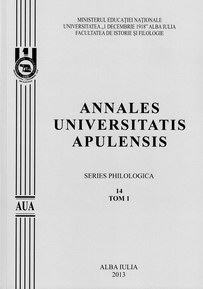Actul lecturii ca experienţă estetică în romanul românesc subiectiv
The Act of Reading as Aesthetic Experience
Author(s): Leontina CopaciuSubject(s): Literary Texts
Published by: Universitatea »1 Decembrie 1918« Alba Iulia
Keywords: reading; experience; aestheticization; individuation; physicality
Summary/Abstract: This paper demonstrates the specificity of aesthetic relations (of various kinds) in the literary experience, focusing on the interpretation of the literary text and the act of reading. The research project focuses on a critical interrogation if there exists an authentic mode, literary specific? Literature is a conduct and gives to the reader opportunities to be. The reader should be participatory and must rather have behaviour, than a deciphering of the literary text. Parallels are achieved among individuality/ detachment/ collaboration (of the reader) and literary work’s placement in the context. Reading actually means to try something, to resume words for taking something of your own existence. Only in this way it is possible an achievement of the literary text settlement in a style of existence. To read what is said (in the text) means the activity, consumption, gestures with no memory, and the act of reading is an update of the object closer to the blood’s rhythms of that one who perceives it. It is justified the literature’s role through the means of interpretation: reading figures (culture-specific) and the practice, useful reading (What is the use of these creation, for me, as a simple reader?) Hence, this literary work?). Hence, the act of reading as individualization act occurs as a release, producing an elevation, an impulse, establishing a rhythm. Depending on the availability of each reader it is chosen the literature’s style the forms which shape a behaviour. The existential dimension, practice of literature, different types of reading and various aesthetic experiences caused by the act of reading, will be demonstrated on three subjective, Romanian novels (Adela, Garabet Ibrăileanu, Rusoaica, Gib I. Mihăescu, Ioana, Anton Holban) and on two works of the '90s (Exuvii, Simona Popescu, Insula, Ioan Groşan). There are emphasized the types of reading re-found in the Romanian characters: the masculine ones (Emil Codrescu, Ragaiac, Sandu) and feminines (Adela, Ioana). The differences lie in the variety of reading texts, in regard to the text reading and the behaviour’s attitude established from textual meaning, connected, then to the erotic experience. Aesthetic relationship’s scheme it’s built on the relationship between a Subject and an Object, where the Subject - the male character (constructed of sensations, feelings, emotions etc.), through an intentional action, practices his active projective identification with the desired Object (the female character). Is an attempt of defining the ego by Alterity (where there exists a Subject and an erotic Object). The relationship inside the aesthetic Romanesque is recoverable in the communication between Literary Work and The Reader. It highlights the act of reading in the novel Exuvii and in the textual prose Insula.
Journal: Annales Universitatis Apulensis. Series Philologica
- Issue Year: 14/2013
- Issue No: 3
- Page Range: 17-32
- Page Count: 16
- Language: Romanian

